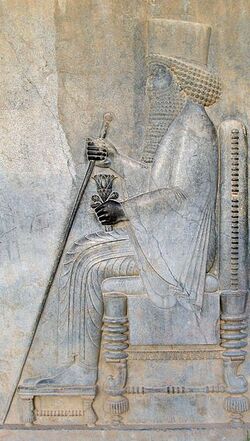
Relief of Darius I (Darius Hystaspis) in Persepolis, who reigned from Sep 522 BCE to Oct 486 BCE[1] (36 years)—Zechariah and Haggai, contemporaries, are recorded in Hebrew Scriptures as having lived in Judah and Jerusalem during the reign of King Darius, specifically during the second year of his reign (Hag 1:1; 2:1, 10, 20; Ezr 5:1, 2; 6:14).
Zechariah, or the book of Zechariah (/zɛkə/; Hebrew: זְכַרְיָה, Modern Zekharya Tiberian Zəḵaryā, "YHWH has remembered"; Arabic: زكريّا Zakariya' or Zakkariya; Greek: Ζαχαρίας Zakharias; Latin: Zacharias) is a text of the Hebrew Scriptures, that concerns the Hebrew prophet Zechariah who is attributed to having lived in Jerusalem c. 520 BCE. Zehcariah is found in Nevi'im of the Tanakh (Hebrew Bible) and is considered one of the "Minor prophets" of the Old Testament.
Textual sources[]
The textual sources for Zechariah derive from 10th century Masoretic text and the Dead Sea Scrolls.[2]
- Masoretic text, Zechariah
- 4Q76a (4QXIIa), Zechariah
- 4Q80e (4QXIIe), Zechariah
- 4Q82g (4QXIIg), Zechariah
- Wadi Murabba‘at (MurXII), Zechariah
- Nahal Hever (8HevXIIgr), Zechariah
Authorship[]
As scrolls are rewritten down through time, variations in copyist styles are found to occur, leaving some modern scholars[3] to believe that books like Zechariah were written by multiple people. However, George Livingstone Robinson's dissertation on Zechariah 9–14 concluded that those chapters had their origin in the period between 518 and 516 BCE and stand in close relation to chapters 1–8, having most probably been composed by Zechariah himself.[4]
Composition[]
- Chapter 5
Chapter 5 of Zechariah begins with a vision (Zechariah 5:1, 2). Zechariah sees, flying through the air, a scroll twenty cubits (30 feet) long and ten cubits (15 feet) wide. It is unrolled, ready to be read and it contains a judgment message (Zech. 5:3). The passage suggests that the scroll has messages for judgement on front and back. Since scrolls were nominally written on one side, the description for the visionary scroll having declarations on both sides, indicates that the matter being presented contains a weighty and serious message.[5]
References[]
- ↑ Munn-Rankin, J.M. Encyclopædia Britannica, Darius I, King of Persia
- ↑ Dead Sea Scrolls: Scriptural Book Transcriptions
- ↑ Coogan, M. A Brief Introduction to the Old Testament: The Hebrew Bible in its Context. (Oxford University Press: Oxford 2009), p. 346-355.
- ↑ Published in The American Journal of Semitic Languages and Literatures, Vol. 12, No. 1/2 (Oct 1895 – Jan 1896), pp. 1–92.
- ↑ WT (2017) Oct 15, Visions of Zechariah, p.22
